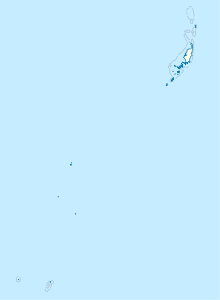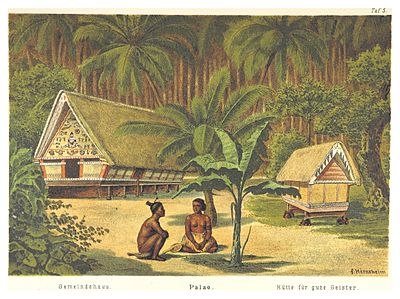Palau Islands
| Palau Islands | ||
|---|---|---|
| Topographic map | ||
| Waters | Pacific Ocean | |
| archipelago | Carolines | |
| Geographical location | 7 ° 28 ' N , 134 ° 32' E | |
|
|
||
| Number of islands | over 300 | |
| Main island | Babelthuap | |
| Total land area | approx. 440 km² | |
| Residents | 19,850 (2005) | |
The Palau Islands , formerly Pelew Islands , the westernmost group of islands in the archipelago of Karolinen and lie in the Pacific Ocean between 2 ° 35 'and 9 ° 0' north latitude and between 130 ° 4 'and 134 ° 40' east longitude, 880 km east of the Philippines and 400 kilometers southwest of the Federated States of Micronesia belonging Yap Islands .
geography
The Palau Islands consist of over 300 islands , some of which are very small , of which only a few are inhabited or would be habitable due to insufficient space. The largest island with an area of 409 square kilometers is Babelthuap . With the exception of the Kayangel Atoll in the north and the island of Angaur in the south, all of the Palau Islands are surrounded by a dense coral reef that is interrupted in several places .
history
The archipelago was spotted by the Spanish explorer Ruy López de Villalobos in 1543 and was originally called Arrecifos . In 1899 the Spaniards colonized the islands and later sold them to the German Empire after their defeat in the Spanish-American War (→ German-Spanish Treaty 1899 ). During the First World War , the islands were occupied by Japan . The city of Koror on the island of the same name became the seat of government of the Japanese South Sea Mandate . In 1944, during World War II , the southern Palau Islands were the scene of a battle between the Japanese and the Americans. The island of Peleliu was particularly hard fought. Since 1994, the Paulau Islands together with some remote islets southwest of the main group have formed the independent island state of Palau .
literature
- George Keate : News from the Pelev Islands in the western part of the Pacific. Translated from Georg Forster . Süddeutsche Zeitung , Anna-Amalia-Bibliothek , Munich 2007, ISBN 3-866-15413-5 (first: Benjamin Gottlob Hoffmann , Hamburg 1789). Series: Modern History of Sea and Land Travel, 1
- Erich Kaiser : Contributions to the petrography and geology of the German South Sea Islands. In: Yearbook of the Royal Prussian Geological State Institute and Mining Academy in Berlin for 1903. Volume XXIV, Berlin 1907, pp. 113–114. pdf



